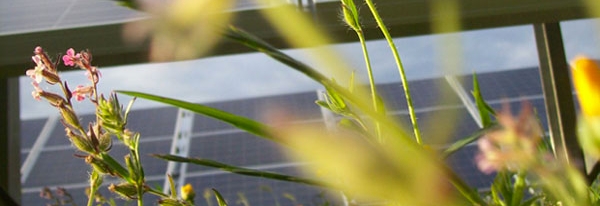Photovoltaic
A photovoltaic system is an electrical system made up of one or more photovoltaic (PV) panels, to convert sunlight into electricity.
The system is typically connected to the electricity grid; the produced electricity, already converted to alternating and synchronized current, is injected into the grid.

Main components
The main components of a photovoltaic system, connected to the electrical grid, are:
- PV array, usefull to collect energy through photovoltaic modules, arranged properly to track the sun;
- Inverter, usefull to stabilize the energy collected, to convert it into alternating current and inject it into the grid;
- Protection and control switchboards, to be located, in accordance with relevant legislation, between the inverter and the grid.
- Connection cables, often overlooked, which must be suitably resistant to UV rays and temperature.
Occupied surface area
The occupied surface area by a photovoltaic system is generally a bit bigger than the one occupied by only photovoltaic modules; if modules are installed in a coplanar way to the surface, they require about 8 m² per kW, both for polycrystalline and monocrystalline technologies. If modules are installed in a non-coplanar way, we must take into account the shadow produced by the panels themself; the surface area used in this case is about 20 m² per kW. The produced energy is greater the more the plant enjoys a favorable exposure to the sun, which is based on sunshine duration; the best results are achieved on particular inclinations, and for exposures as much as possible towards the south.
Solar Tracking System for PhotoVoltaic Panels can maximize the uptake of solar radiation, and for this reason these systems are spreading more and more. They are able to adjust the angle of the solar panel on the angle of sunlight, during the day and seasons.
The BIPV and architectural integration
We want to mention the BIPV, that stands for Building Integrated Photovoltaics, or Building Integrated Photovoltaic Systems. The architectural integration consists of integrating photovoltaics modules into the building envelope, such as the roof or the façade. The techniques may include:
- Direct replacement of roof covering (eg shingles or tiles) with a suitable coating, where photovoltaic modules will be incorporated;
- Use of appropriate integration technologies, such as thin films;
- Use of solar glazings and laminates: (semi) transparent modules can be used to replace a number of architectural elements commonly made with glass or similar materials, such as windows and skylights. Glazing can be made as simple glass/glass laminate or as complex isolation glass/glass laminate. Laminate can consist of monocrystalline silicon, thin film cells or from transparent cells. Solar glazing control glass allows a higher level of visible light to pass through a window.
BIPV systems are more expensive than the traditional systems; their aesthetic results are so valuable that even the PV FIT (Feed In Tariffs) protects and encourages it, recognizing a significantly higher feed-in tariff. At the same time, by simultaneously serving as building envelope material and power generator, BIPV systems can provide savings in materials and electricity costs, reduce use of fossil fuels and emission of ozone depleting gases, and add architectural interest to the building.
The power rating of a PV system is measured by the sum of the rated output of each photovoltaic modules, and the unit of measurement is the kilowatt (symbol: kW).
